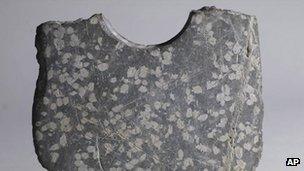China stone axes 'display ancient writing'
- Published

The stone axes are part of a large trove of artefacts
Fragments of two ancient stone axes found in China could display some of the world's earliest primitive writing, Chinese archaeologists say.
The markings on the axes, unearthed near Shanghai, could date back at least 5,000 years, the scientists say.
But Chinese scholars are divided on whether the markings are proper writing or a less sophisticated stream of symbols.
The world's oldest writing is thought to be from Mesopotamia from 3,300 BC.
The stone fragments are part of a large trove of artefacts discovered between 2003 and 2006 at a site just south of Shanghai, says the BBC's Celia Hatton in Beijing.
But it has taken years for archaeologists to examine their discoveries and release their findings, our correspondent adds.
The findings have not been reviewed by experts outside China, reports say.
"The main thing is that there are six symbols arranged together and three of them are the same," lead archaeologist Xu Xinmin told local reporters, referring to markings on one of the pieces.
"This clearly is a sentence expressing some kind of meaning".
Cao Jinyan, a well-known scholar on ancient writing, also told local media that the markings could be an early form of writing.
"Although we cannot yet accurately read the meaning of the 'words' carved on the stone axes, we can be certain that they belong to the category of words, even if they are somewhat primitive," he said.
Some scholars, however, remain unconvinced. Archaeologist Liu Zhao from Fudan University in Shanghai told the Associated Press news agency they "do not have enough material" to make conclusions.
If proven, the stone axes will be older than the earliest proven Chinese writing found on animal bones, which dates back 3,300 years.